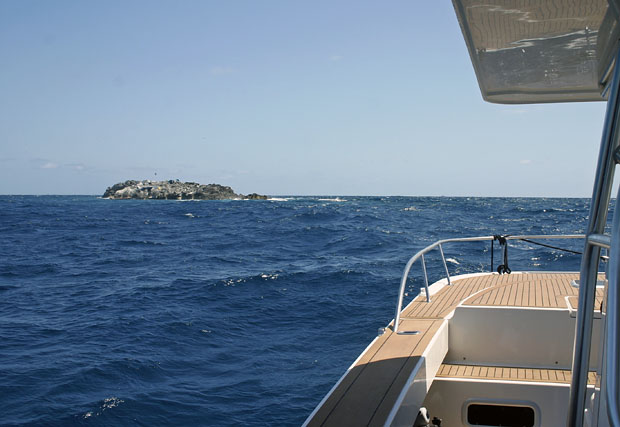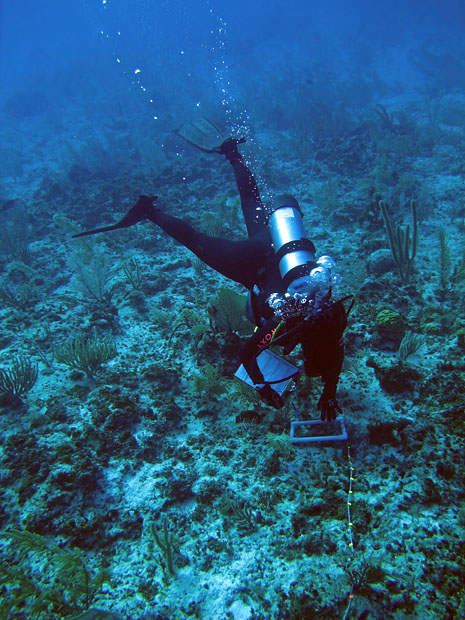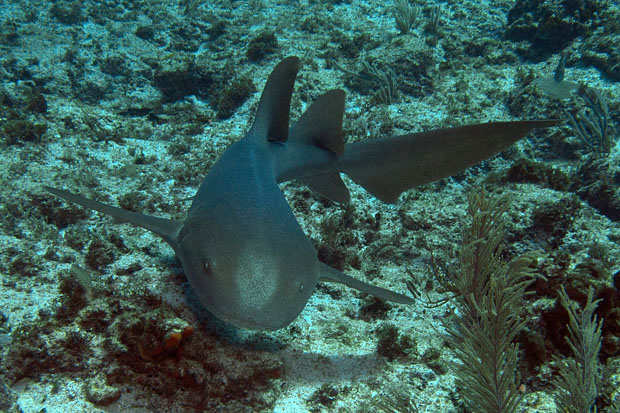St. Patrick’s Day saw the Calcutta leaving early for the far eastern end of Pedro Bank. The route took us across an area of deeper water and larger swells, so it took close to three hours of hard bouncing to cover the 41 km (25.5. mi) to Portland Rock, without a doubt one of the least inviting islets in the Caribbean. A nub of steep, sharp rock lashed by waves and covered with guano, it still had a few fisherman’s tents on top and a handful of fishing boats pulled up nearby.

Unfortunately, even after asking these knowledgeable locals for advice, we weren’t able to find any spots with more than minimal coral cover, and the underwater visibility was low. Andy and Phil decided it would make better sense to backtrack another 30 minutes to tiny Blower Rock. The first dive was marked by huge colonies of star coral (Montastraea faveolata and M. annularis) up to 2.6 m (8.5 ft) across. We spotted our first nurse shark as soon as we entered the water, but Rachel soon got a closer look.
Between benthic surveys, Rachel had speared a small lionfish, trimmed off its venomous spines with a large pair of scissors and left both in a bright orange mesh bag on the bottom to collect later. A few minutes later, two nearby divers heard her rattling an underwater noisemaker and looked up to see her pointing excitedly. A nurse shark was thrashing around with the bag, trying to get the fresh filet inside. When a grey reef shark appeared, the thief decided took off with its prize. Back on board, it was hard to tell whether Rachel was more surprised at what happened or angry that her gear was gone.

The next dive took us into post-apocalyptic landscape of broken elkhorn coral (Acropora palmata) piled meters deep in places, with a few reassuringly large living patches. This yellow-brown coral spreads out in wide, flat plates with knobby fringes, more like moose antlers than elk horns. It’s a shallow-water species, forming big thickets at around 6 m (20 ft), and it can grow surprisingly fast: up to 10 cm (3.9 in) per year. Elkhorn used to be one of the most important and abundant reef-building corals in the Caribbean, but since 1980 a combination of climate change, disease, predation, hurricane damage and human impact has killed an estimated 90-95%. Now both elkhorn and staghorn coral (A. cervicornis), which has declined up to 98% in places, are listed as threatened in the US and critically endangered on the IUCN Red List.
Large and small nurse sharks circled through the maze of broken coral for the entire dive, sometimes coming within a few feet of the researchers. They weren’t acting hostile, but it does make it hard to concentrate on a transect, head down scribbling notes or analyzing the seafloor, knowing at any moment you could look up and see a five-foot shark just a tail flick away. After that, it was almost a disappointment to see only one or two nurse sharks during the third dive at Beth Rock, 12 km (7.5 mi) closer to the Golden Shadow.
Nurse sharks usually avoid divers by day, and on the way back to the ship we wondered why we were seeing so many (almost one on every dive so far) and why they seemed so unafraid. One idea is that they’re learning to see divers, or at least their presence, as a source of food. Local fishermen kill every lionfish they see but leave the bodies behind, preferring to fill their nets with other species. Are the overly friendly nurse sharks looking for lionfish leftovers?

The return to the Golden Shadow seemed to fly by. It was that time of late afternoon when the sunlight shifts from brutal to beautiful. Dolphins and flying fish leapt out of a much calmer sea than this morning. It’s hard to believe there are only three days left of the expedition.
(Photos/Images by: 1-2 Julian Smith, 3 Ken Marks)
To follow along and see more photos, please visit us on Facebook! You can also follow the expedition on our Global Reef Expedition page, where there is more information about our research and team members.
